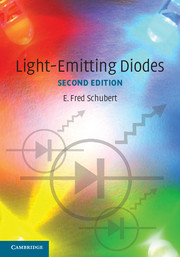Book contents
- Frontmatter
- Contents
- Preface
- 1 History of light-emitting diodes
- 2 Radiative and non-radiative recombination
- 3 Theory of radiative recombination
- 4 LED basics: Electrical properties
- 5 LED basics: Optical properties
- 6 Junction and carrier temperatures
- 7 High internal efficiency designs
- 8 Design of current flow
- 9 High extraction efficiency structures
- 10 Reflectors
- 11 Packaging
- 12 Visible-spectrum LEDs
- 13 The AlGaInN material system and ultraviolet emitters
- 14 Spontaneous emission from resonant cavities
- 15 Resonant-cavity light-emitting diodes
- 16 Human eye sensitivity and photometric qualities
- 17 Colorimetry
- 18 Planckian sources and color temperature
- 19 Color mixing and color rendering
- 20 White-light sources based on LEDs
- 21 White-light sources based on wavelength converters
- 22 Optical communication
- 23 Communication LEDs
- 24 LED modulation characteristics
- Appendix 1 Frequently used symbols
- Appendix 2 Physical constants
- Appendix 3 Room temperature properties of III–V arsenides
- Appendix 4 Room temperature properties of III–V nitrides
- Appendix 5 Room temperature properties of III–V phosphides
- Appendix 6 Room temperature properties of Si and Ge
- Appendix 7 Periodic system of elements (basic version)
- Appendix 8 Periodic system of elements (detailed version)
- Index
6 - Junction and carrier temperatures
Published online by Cambridge University Press: 05 September 2012
- Frontmatter
- Contents
- Preface
- 1 History of light-emitting diodes
- 2 Radiative and non-radiative recombination
- 3 Theory of radiative recombination
- 4 LED basics: Electrical properties
- 5 LED basics: Optical properties
- 6 Junction and carrier temperatures
- 7 High internal efficiency designs
- 8 Design of current flow
- 9 High extraction efficiency structures
- 10 Reflectors
- 11 Packaging
- 12 Visible-spectrum LEDs
- 13 The AlGaInN material system and ultraviolet emitters
- 14 Spontaneous emission from resonant cavities
- 15 Resonant-cavity light-emitting diodes
- 16 Human eye sensitivity and photometric qualities
- 17 Colorimetry
- 18 Planckian sources and color temperature
- 19 Color mixing and color rendering
- 20 White-light sources based on LEDs
- 21 White-light sources based on wavelength converters
- 22 Optical communication
- 23 Communication LEDs
- 24 LED modulation characteristics
- Appendix 1 Frequently used symbols
- Appendix 2 Physical constants
- Appendix 3 Room temperature properties of III–V arsenides
- Appendix 4 Room temperature properties of III–V nitrides
- Appendix 5 Room temperature properties of III–V phosphides
- Appendix 6 Room temperature properties of Si and Ge
- Appendix 7 Periodic system of elements (basic version)
- Appendix 8 Periodic system of elements (detailed version)
- Index
Summary
The temperature of the active region crystal lattice, frequently referred to as the junction temperature, is a critical parameter. The junction temperature is relevant for several reasons. Firstly, the internal quantum efficiency depends on the junction temperature. Secondly, hightemperature operation shortens the device lifetime. Thirdly, a high device temperature can lead to degradation of the encapsulant. It is therefore desirable to know the junction temperature as a function of the drive current.
Heat can be generated in the contacts, cladding layers, and the active region. At low current levels, heat generation in the parasitic resistances of contacts and cladding layers is small due to the I2R dependence of Joule heating. The dominant heat source at low current levels is the active region, where heat is created by non-radiative recombination. At high current levels, the contribution of parasitics becomes increasingly important and can even dominate.
There are several different ways to measure the junction temperature, which include micro-Raman spectroscopy (Todoroki et al., 1985), threshold voltage (Abdelkader et al., 1992), thermal resistance (Murata and Nakada, 1992), photothermal reflectance microscopy (Epperlein, 1990), electroluminescence (Epperlein and Bona, 1993), photoluminescence (Hall et al., 1992) and a non-contact method based on the peak ratio of a dichromatic source (Gu and Narendran, 2003). Most methods are indirect methods that infer the junction temperature from an easily measurable parameter.
- Type
- Chapter
- Information
- Light-Emitting Diodes , pp. 101 - 112Publisher: Cambridge University PressPrint publication year: 2006
- 3
- Cited by



